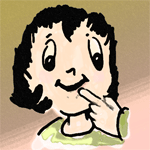Skip over navigation

Imagine a 4 by 4 by 4 cube hanging in front of you with just the front face facing you.
The cube is made up of 4x4x4, 64 cubes.
You drill a hole through the four corner cubes, that are facing you, all the way through to the back.

A friend looks down on the cube, from above, and they also drill four holes through their four corner cubes all the way through to the bottom.
You and your friend examine all the 64 small cubes.
How many will not have holes drilled through them?
What if the same kind of activity happened with a new 4 by 4 by 4 cube but, this time, you drill holes through the four centre cubes that are facing you and your friend drills holes through the four centre cubes that are facing them.
You and your friend examine all the 64 small cubes.
How many will not have holes drilled through them?
Please do send in your solutions, describing how you worked them out.
Ideally, it would be good to encourage your class to tackle this challenge purely by trying to imagine what is happening.
To convince you and each other of their solutions, they will need to explain particularly carefully what they are picturing, which can be quite tricky, and you may find that they gesticulate rather a lot! In order to reach a joint conclusion, you might find it helpful to make a model of the cube from interlocking cubes.
When you drill your holes, can you picture which small cubes have got holes in them?
How many do you drill holes in?
Now think about your friend. Can you picture the small cubes that he or she drills holes in?
Are any of the cubes your friend drills ones that you've already drilled?
Are some of these cubes ones that you haven't already drilled?
Children could investigate different ways of drilling holes.
It would be a good idea to try Start Cube Drilling before tackling this problem as that would make a nice introduction.

Or search by topic
Number and algebra
Geometry and measure
Probability and statistics
Working mathematically
Advanced mathematics
For younger learners
Cube Drilling
Age 7 to 11
Challenge Level 





- Problem
- Getting Started
- Student Solutions
- Teachers' Resources
Cube Drilling
This activity is all about imagining, like you might when you listen to a story or poem.
There is no need to write or draw anything
BUT
talking about it could be good!

Imagine a 4 by 4 by 4 cube hanging in front of you with just the front face facing you.
The cube is made up of 4x4x4, 64 cubes.
You drill a hole through the four corner cubes, that are facing you, all the way through to the back.

A friend looks down on the cube, from above, and they also drill four holes through their four corner cubes all the way through to the bottom.
You and your friend examine all the 64 small cubes.
How many will not have holes drilled through them?
What if the same kind of activity happened with a new 4 by 4 by 4 cube but, this time, you drill holes through the four centre cubes that are facing you and your friend drills holes through the four centre cubes that are facing them.
You and your friend examine all the 64 small cubes.
How many will not have holes drilled through them?
Please do send in your solutions, describing how you worked them out.
Why do this problem?
The whole idea of this problem is to invite children to picture something in their mind. Pupils will need to be familiar with properties of a cube. Visualising, in this problem, includes picturing something in your head and "doing something to it". This is a useful tool to have when solving problems. The problem focuses entirely on visualisation in order to encourage pupils to have a go at imagining. The more opportunities we give children to practise visualisation, the more comfortable they will become with using it of their own accord. Those pupils who manage it may very well wonder "What would happen if . . .?" and their curiosity starts being put into place and they therefore continue to explore further.
Possible approach
Ideally, it would be good to encourage your class to tackle this challenge purely by trying to imagine what is happening.To convince you and each other of their solutions, they will need to explain particularly carefully what they are picturing, which can be quite tricky, and you may find that they gesticulate rather a lot! In order to reach a joint conclusion, you might find it helpful to make a model of the cube from interlocking cubes.
Key questions
When you drill your holes, can you picture which small cubes have got holes in them?How many do you drill holes in?
Now think about your friend. Can you picture the small cubes that he or she drills holes in?
Are any of the cubes your friend drills ones that you've already drilled?
Are some of these cubes ones that you haven't already drilled?
Possible extension
Children could investigate different ways of drilling holes.
Possible support
It would be a good idea to try Start Cube Drilling before tackling this problem as that would make a nice introduction.You may also like
Little Boxes
How many different cuboids can you make when you use four CDs or DVDs? How about using five, then six?

